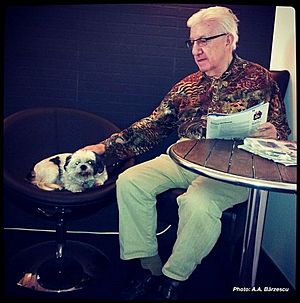Miguel-Ángel Cárdenas facts for kids
Quick facts for kids
Miguel-Ángel Cárdenas
|
|
|---|---|

Miguel-Ángel Cárdenas 2012
|
|
| Born | October 3, 1934 |
| Died | June 2, 2015 (aged 80) |
| Nationality | Dutch, Colombian |
| Known for | Painting, Video art, Drawing, Photography, Assemblage art |
| Movement | Pop Art, Nouveau Realisme |
Miguel-Ángel Cárdenas (born October 3, 1934 – died June 2, 2015) was a very creative artist. He was known as Michel Cardena. Miguel-Ángel was from Colombia and also became a Dutch citizen. He was a painter who worked in styles like New Realism and Pop Art. He was also a pioneer in video art in the Netherlands. This means he was one of the first artists to use video in his artwork. His art included many different types of media. These were painting, drawing, video, photography, and even art made from putting objects together.
Miguel-Ángel Cárdenas: His Life Story
Miguel-Ángel Cárdenas was born in Espinal, Colombia, in 1934. From 1953 to 1957, he studied architecture. He went to the National University of Colombia in Bogota. He also studied visual art at the Escuela de Bellas Artes in Bogota. In 1961, the Ministry of Culture of Colombia gave him a scholarship. A scholarship is money given to a student to help them study. This allowed him to study at the Barcelona School of Graphic Arts.
In 1962, Cárdenas moved to the Netherlands. He lived there for the rest of his life. Soon after arriving, he had his own art show. This show was at the Gemeentemuseum Den Haag. He also took part in a big art show called "Pop Art and New Realism." This show happened from 1964 to 1965. It was held in The Hague, Brussels, Vienna, and Berlin. Famous artists like Marcel Duchamp, Andy Warhol, and Roy Lichtenstein also had their art in this show.
In 1969, Queen Beatrix of the Netherlands (who was Crown Princess then) invited Cárdenas to a special event. He was one of ten artists invited to her castle, Drakesteijn. His performance was called "Symphony for seven waiters."
Between 1963 and 1978, Cárdenas received several scholarships. These were from the Ministry of Culture of the Netherlands. One scholarship helped him travel to the US and Canada.
Cárdenas began using video in his art in 1970. Two years later, he helped start the 'In-Out Center'. This was the first artists' cooperative in the Netherlands. A cooperative is a group of people who work together for a shared goal. This center had its own art gallery in Amsterdam. The events held there helped new art forms grow in the Netherlands. These included body art and performance art.
In 1986, Cárdenas decided to go back to painting. This was his first type of art.
During the 1970s and 1980s, Cárdenas taught art. He lectured at several Dutch art schools. These included the Rietveld Academy and the Academy of Fine Arts in Arnhem.
His art was shown in the 'Snapshot No.5' exhibition in 1989. This was at the Stedelijk Museum in Amsterdam. The museum director, Wim Beeren, wrote about Cárdenas. He said that Cárdenas brought new art ideas to the Netherlands. These ideas included Pop Art and New Realism.
In 1990, Cárdenas won third prize at an art show in Osaka, Japan. A year later, he received another scholarship. This one was to study calligraphy in Tokyo, Japan. Calligraphy is the art of beautiful handwriting.
The Dutch government often supported his work with grants. His art was shown in many solo and group exhibitions. These were in the Netherlands and around the world.
In 2004, Queen Beatrix of the Netherlands honored Cárdenas. She made him an Officer in the Order of Orange-Nassau. This is a special award.
Exploring Video Art
Cárdenas started using video because it offered new ways to create art. His videos used different styles. Some were in black and white. They showed performances happening in real-time, like a live show. Others told detailed stories. They used advanced editing to put different parts together. Cárdenas often used ideas of "duality" in his videos. This means showing two things that are different or that copy each other.
One main idea in Cárdenas's video art was heat. His live performances often explored this theme. He would try to "warm up" people or objects. He wanted to melt away the "coldness" he felt in Dutch society. From 1971, he even called himself "Cardena Warming up etc. etc. etc. Company."
Cárdenas also wrote a private book in 1980. It was called “Black and white and sometimes colorful No. 2.” This book described two of his performances. It also included articles about video art and interviews.
His video art was shown in many museums and galleries. One famous place was the Museum of Modern Art in New York City in 1981. In the same year, his work was part of a big show. This show was at the Museum Boijmans Van Beuningen in Rotterdam.
Where to See His Art
Miguel-Ángel Cárdenas's art can be found in many important collections and museums. Here are some of them:
- Banco de la República, Bogota, Colombia
- Stedelijk Museum, Amsterdam, Netherlands
- Museum Boymans-van Beuningen, Rotterdam, Netherlands
- Gemeente Museum, The Hague, Netherlands
- Bodenseemuseum, Friedrichshafen, Germany
- Borås Konstmuseum, Borås, Sweden
- Moderna Museet, Stockholm, Sweden
- Het Princessehof, Leeuwarden, Netherlands
- Amro Bank Collection, Amsterdam, Netherlands
- Bessel and Pierrete Kok Collection, Brussels, Belgium
- Professor Shigenobu Kimura Collection, Osaka, Japan
- Hara Museum, Tokyo, Japan
- Collectie Bouwfonds, Hoevelaken, Netherlands
- Bonhefanten Museum, Maastricht, Netherlands
- Wetering Galerie, Amsterdam, Netherlands
See also

